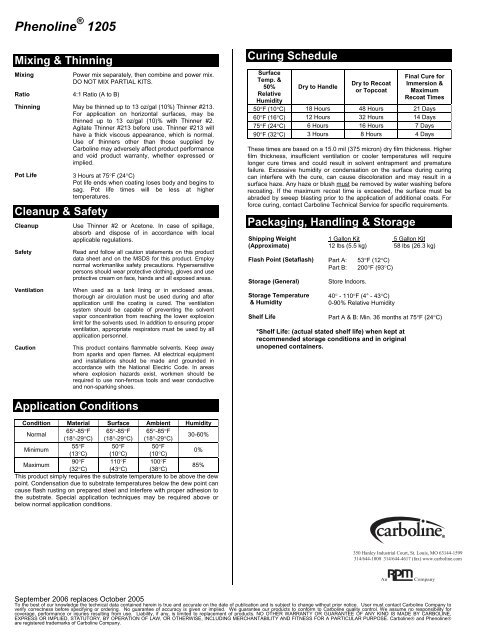English (United Kingdom) - Paul Wurth
English (United Kingdom) - Paul Wurth
English (United Kingdom) - Paul Wurth
- TAGS
- wurth
- www.paulwurth.com
You also want an ePaper? Increase the reach of your titles
YUMPU automatically turns print PDFs into web optimized ePapers that Google loves.
Phenoline ® 1205<br />
Mixing & Thinning<br />
Mixing Power mix separately, then combine and power mix.<br />
DO NOT MIX PARTIAL KITS.<br />
Ratio 4:1 Ratio (A to B)<br />
Thinning May be thinned up to 13 oz/gal (10%) Thinner #213.<br />
For application on horizontal surfaces, may be<br />
thinned up to 13 oz/gal (10)% with Thinner #2.<br />
Agitate Thinner #213 before use. Thinner #213 will<br />
have a thick viscous appearance, which is normal.<br />
Use of thinners other than those supplied by<br />
Carboline may adversely affect product performance<br />
and void product warranty, whether expressed or<br />
implied.<br />
Pot Life 3 Hours at 75°F (24°C)<br />
Pot life ends when coating loses body and begins to<br />
sag. Pot life times will be less at higher<br />
temperatures.<br />
Cleanup & Safety<br />
Cleanup Use Thinner #2 or Acetone. In case of spillage,<br />
absorb and dispose of in accordance with local<br />
applicable regulations.<br />
Safety Read and follow all caution statements on this product<br />
data sheet and on the MSDS for this product. Employ<br />
normal workmanlike safety precautions. Hypersensitive<br />
persons should wear protective clothing, gloves and use<br />
protective cream on face, hands and all exposed areas.<br />
Ventilation When used as a tank lining or in enclosed areas,<br />
thorough air circulation must be used during and after<br />
application until the coating is cured. The ventilation<br />
system should be capable of preventing the solvent<br />
vapor concentration from reaching the lower explosion<br />
limit for the solvents used. In addition to ensuring proper<br />
ventilation, appropriate respirators must be used by all<br />
application personnel.<br />
Caution This product contains flammable solvents. Keep away<br />
from sparks and open flames. All electrical equipment<br />
and installations should be made and grounded in<br />
accordance with the National Electric Code. In areas<br />
where explosion hazards exist, workmen should be<br />
required to use non-ferrous tools and wear conductive<br />
and non-sparking shoes.<br />
Application Conditions<br />
Condition Material Surface Ambient Humidity<br />
Normal<br />
65°-85°F<br />
(18°-29°C)<br />
65°-85°F<br />
(18°-29°C)<br />
65°-85°F<br />
(18°-29°C)<br />
30-60%<br />
Minimum<br />
55°F<br />
(13°C)<br />
50°F<br />
(10°C)<br />
50°F<br />
(10°C)<br />
0%<br />
Maximum<br />
90°F<br />
(32°C)<br />
110°F<br />
(43°C)<br />
100°F<br />
(38°C)<br />
85%<br />
This product simply requires the substrate temperature to be above the dew<br />
point. Condensation due to substrate temperatures below the dew point can<br />
cause flash rusting on prepared steel and interfere with proper adhesion to<br />
the substrate. Special application techniques may be required above or<br />
below normal application conditions.<br />
Curing Schedule<br />
Surface<br />
Temp. &<br />
50%<br />
Relative<br />
Humidity<br />
Dry to Handle<br />
Dry to Recoat<br />
or Topcoat<br />
Final Cure for<br />
Immersion &<br />
Maximum<br />
Recoat Times<br />
50°F (10°C) 18 Hours 48 Hours 21 Days<br />
60°F (16°C) 12 Hours 32 Hours 14 Days<br />
75°F (24°C) 6 Hours 16 Hours 7 Days<br />
90°F (32°C) 3 Hours 8 Hours 4 Days<br />
These times are based on a 15.0 mil (375 micron) dry film thickness. Higher<br />
film thickness, insufficient ventilation or cooler temperatures will require<br />
longer cure times and could result in solvent entrapment and premature<br />
failure. Excessive humidity or condensation on the surface during curing<br />
can interfere with the cure, can cause discoloration and may result in a<br />
surface haze. Any haze or blush must be removed by water washing before<br />
recoating. If the maximum recoat time is exceeded, the surface must be<br />
abraded by sweep blasting prior to the application of additional coats. For<br />
force curing, contact Carboline Technical Service for specific requirements.<br />
Packaging, Handling & Storage<br />
Shipping Weight<br />
(Approximate)<br />
1 Gallon Kit<br />
12 lbs (5.5 kg)<br />
Flash Point (Setaflash) Part A: 53°F (12°C)<br />
Part B: 200°F (93°C)<br />
Storage (General) Store Indoors.<br />
Storage Temperature<br />
& Humidity<br />
40° - 110°F (4° - 43°C)<br />
0-90% Relative Humidity<br />
5 Gallon Kit<br />
58 lbs (26.3 kg)<br />
Shelf Life Part A & B: Min. 36 months at 75°F (24°C)<br />
*Shelf Life: (actual stated shelf life) when kept at<br />
recommended storage conditions and in original<br />
unopened containers.<br />
September 2006 replaces October 2005<br />
To the best of our knowledge the technical data contained herein is true and accurate on the date of publication and is subject to change without prior notice. User must contact Carboline Company to<br />
verify correctness before specifying or ordering. No guarantee of accuracy is given or implied. We guarantee our products to conform to Carboline quality control. We assume no responsibility for<br />
coverage, performance or injuries resulting from use. Liability, if any, is limited to replacement of products. NO OTHER WARRANTY OR GUARANTEE OF ANY KIND IS MADE BY CARBOLINE,<br />
EXPRESS OR IMPLIED, STATUTORY, BY OPERATION OF LAW, OR OTHERWISE, INCLUDING MERCHANTABILITY AND FITNESS FOR A PARTICULAR PURPOSE. Carboline® and Phenoline®<br />
are registered trademarks of Carboline Company.




